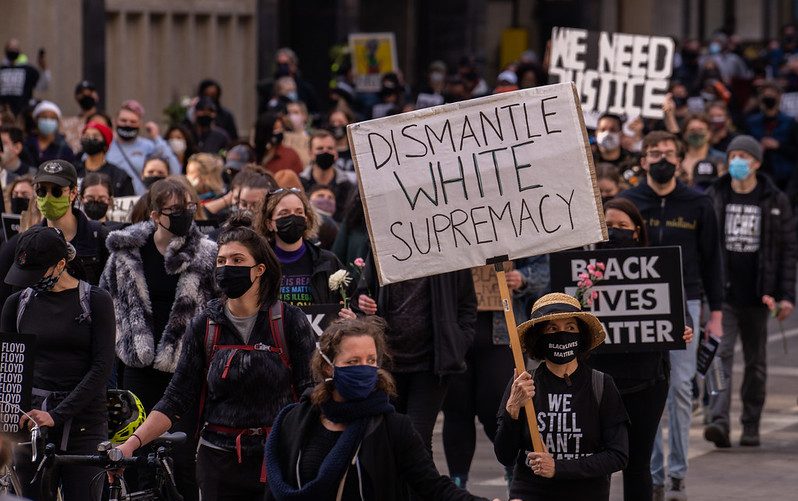Introduction
In the past year, since the January 6th attacks on the U.S. Capitol, white supremacy and right-wing extremist, militant groups have been experiencing a rise in recruitment and have been undergoing many changes, largely due to the changing social and political structures within the United States.
Renewed discussion about fandoms and white nationalist/right-wing movements has been occurring in the media since the January 2021 storming of the Capitol building. The white supremacy movement as a whole fits into a lot of the commonalities that are associated with fandom. This essay examines the white supremacist movement in the 1990’s to various practices that are common within fandom. In order to allow the reader to understand the movement more, narrowing it down to a specific time period is a must. Yet, before one can begin the discussion of whether white supremacy can be associated with a fandom or not, a clarification on what white supremacy is and a certain amount of history is required in order to fully understand the movement and to better follow the argument of partially classifying the white supremacist movement as a fandom.
A Definition and History of the White Supremacist Movement in the United States
The term white supremacy is difficult to define as there are multiple encompassing parts to it. The best way I can describe it is as an umbrella term for a movement that has extremely strong ties to white superiority and right-wing extremism. The movement is also built on anti-government views, 2nd amendment rights, sovereignty, Christianity, and a predication for violence. Groups like the Aryan Nations, Neo-Nazis, the Aryan Brotherhood, and the Ku Klux Klan (KKK) are all grouped under the banner of white supremacy.
The white supremacy movement in the United States is somewhat difficult to pin down, as it has undergone rebirth and death multiple times and being that the core beliefs of the movement (racism, anti-authority, gun rights, and freedom of religion) all trace back to America’s founding. Most, however, would characterize the birth of white supremacy (as a terrorist group) in the U.S. with the end of the Civil War and the birth of the KKK. As defined by the Southern Poverty Law Center (SPLC), the KKK was “a vigilante group to intimidate Southern blacks – and whites who would help them – and to prevent them from enjoying basic civil rights”.
The Klan dismantled itself when Jim Crow laws were passed but was reborn in the 1920’s, where it expanded its targets by including immigrants, Catholics, and Jews (though its anti-Catholic sentiment decreased with time). Once again, its power diminished significantly and would re-emerge with the Civil Rights efforts of the 1960’s only to recede into the background in the mid-1970’s.
However, the KKK is only one form of white supremacy. In the 1930’s and 40’s, Hitler’s Nazis swept Europe and gave rise to many right-wing movements in the United States (the Silver Shirts being a prime example). These movements, built upon racism, anti-Semitism, and violence, later combined their racial views with those of the right-wing, additionally focusing on anti-government and pro-gun rights legislation. This forming of ideas resulted in the creation of groups like the Aryan Nations and the overall militia movement. The cementation of these racial views with right-wing ideology occurred in the 1990’s with events like Ruby Ridge (in which the Weaver family with ties to the Aryan Nations were engaged in a standoff that left a woman dead from an FBI sniper’s bullet) and Waco (men, women, and children of a fundamentalist Christian cult perished in a fire provoked by federal agents looking to seize the cult’s weaponry).
The Fandom Aspects of White Supremacy
Fandom has many forms of participation and engagement through fan pilgrimages, totemism, screaming, space and attention-seeking activities, and subcultures. All of these are central to how fandoms operate in society and are integral to our understanding of what constitutes a fan, and they engage with the text they hold up so highly.
Starting with fan pilgrimages, these, in the context of fandom, are instances where fans will travel to a physical place that is of strong cultural significance with the text they hold dear to their hearts. This is entirely dependent upon the fandom that the person is associated with; for example, for some fans of The Lord of the Rings series, this would be going to visit the Hobbiton movie set in Matamata, New Zealand. Another example, on a smaller scale, would be going to see a band perform in a club or other music venue. These pilgrimages are quite common within many fandoms and vary in type depending upon the fandom. The white supremacist movement is no different.
With white supremacy, many followers or proponents of the movement frequent places where potential conflict may arise. This is exemplified through the 1992 Ruby Ridge incident, the 1993 Waco Siege, and the 2014 Confederate flag rally in South Carolina. With the Ruby Ridge incident, while not as broadcast as Waco, many associated peoples with the white supremacy movement visited the site to protest the federal government’s involvement or show support for the perceived values for which the Weaver family stood for (gun rights, Christianity, sovereignty). The same thing occurred at Waco, with many people coming by the Branch Davidian compound to view what was happening and protest the government’s involvement, including Timothy McVeigh, the Oklahoma City bomber who was heavily involved in the movement and came to show support for the broad, overall goals of the movement. This type of pilgrimage also enabled many to become involved with others who shared their ideology or were white supremacists.
However, these are not the only types of pilgrimages that white supremacists are active in. The practice of going to gun shows play a large role in the white supremacist, right-wing movement. Being a hotbed of anti-government and 2nd amendment rights sentiment, it is quite logical to believe that white supremacists and others taken with racial ideology congregate there. In the documentary Oklahoma City, Mark Potok, the former editor for the Southern Poverty Law Center’s magazine Intelligence Report, states, “[talking about Timothy McVeigh’s exposure to the radical right] And probably the single most important place where the ideas of the radical right were spread were gun shows”. Gun shows are key places for white nationalists to gather, with persons certainly travelling to any show in any Southern (or Northern) state even hosting large numbers of right-wing or, even more threateningly, white nationalist/supremacist views.
Totemism, like in fandom, plays a huge role in the white supremacy movement. As described by researcher Mark Duffett, totemism is “the means by which individuals simultaneously connect to their society and also repress that connection from their explicit understanding”. This is quite common within fandom and is abundantly present within the movement. One of the most iconic symbols within white supremacy (and domestic terrorism) is the burning crosses of the Ku Klux Klan. However, this is not purely a place where members can take part in a ceremony, but also a place where there is a physical gathering of likeminded individuals. In a BBC documentary titled KKK: The Fight for White Supremacy, which explores a North Carolina based KKK group amidst the 2015 Charleston church shooting, showcases one of these cross-burning ceremonies. In this documentary, young children can be seen engaging in football, and many members make the comparison that it feels like a “church group” atmosphere. Additionally, a potluck is set up for members of the movement and their families to engage in, adding to that church-like atmosphere. Through these ceremonies, members are able to connect to others and engage with others who share their views, as well as speak freely as they are in free space and do not need to hide their identity.
This is also not limited to just the Ku Klux Klan, which has been having these types of congregations for years. In the 1980’s and 90’s, the Aryan Nations held the “Aryan World Congress” which functioned as a gathering of like-minded people, with members of the KKK, Neo-Nazis, and biker gangs all coming, numbering around a few hundred. While it may not seem like a large number, this was a massive gathering that had many people from the far right come and take part in, including people like Louis Beam (former Grand Dragon of the KKK), Don Black (a self-proclaimed Grand Dragon of the KKK), or Richard Spencer (a key ideologue of the new right-wing in the 21st century). This event allowed all of these people to take part in activities based around white supremacist ideologies and become well acquainted with others in the overall movement.
All of these modes of fan practice also heavily play into space, the providing of a space where fans can “create a sense of community” through rituals and social support networks.
One of the best examples of this is in a website titled Stormfront, established by Don Black (a self-proclaimed Grand Dragon of the KKK) in the 1990’s. The site is a bastion of white supremacy, anti-government, anti-Semitic/minority/immigrant sentiments. According to the site, there are over 300,000 registered members and span across the globe (with specific forums for each country or region – Great Britain, Russia, Eastern Europe, etc.). Having visited the site (though not registered), this space provides an area for white supremacists to engage with others and discuss topics ranging from current events to dating advice to homeschooling. In the various chats, race is brought up constantly. The subject of their discussions frequently centers back around the members’ object of hatred and promotes their one-sided, wildly incorrect view of the world.
This creation of the web forum Stormfront also points to how the movement has begun changing with time, taking on new electronic methods of engaging with like-minded people and sharing their views. Like any other fandom, sociality and discussion of their desired fandom is an important aspect, and the internet (as well as social media) has helped in various ways to connect more compatible minds together. This connection significantly helps ideas and theories on race and politics and society be shared, as well as makes bonds that could very easily turn violent. This electronic connection between people of shared ideas has made the possibility of groups of white supremacists going out and committing violent acts against those they dislike (federal agents, Jews, minorities) and trying to incite a “race war” (a very common phenomenon in the movement).
Another key aspect of fandom and the white supremacy movement is the practice of screaming. Duffett defines screaming as it is commonly seen by the media as “draw[ing] attention to the artist and the phenomenon he or she creates”. While this is how the media generally perceives fans and is not the case Duffett is making in his paper, the media’s definition of fandom is more accurate in describing the white supremacist community’s actions.
Some of the most recognizable actions that white supremacists make are in symbols. From giving the Nazi salute and yelling “Sieg Heil” (common in the Neo-Nazi and overall white supremacy movement) to burning crosses (centralized mainly in the KKK), all of these draw attention to the person themselves and the action they are creating.
This is exemplified once again in the previously mentioned BBC documentary. Near the end of the documentary (when members of the movement are protesting the removal of the Confederate flag at the South Carolina Statehouse), members of the movement frequently yell “White Power” and give the Nazi salute, provoking the predominantly black protesters.
Not only is this meant to be confrontational and display their pride, but it is meant to draw attention to their movement and what they are fighting for. While many Klansmen claim in the documentary that they are not being violent (theoretically true), they absolutely ignore the fact that they are inciting violent behavior through their actions.
The form of cosplay also comes into play within the white supremacist movement. While it may not seem like cosplay comes into play within the movement, many of the white supremacist movements engage in these costume activities.
Within the broad coalition of white supremacy, the Klan has their white robes, the Aryan Nations have their light blue shirts, and a lot of Neo-Nazi groups wear clothing that harkens back to Nazi German Sturmabteilung or Schutzstaffel uniforms. It can be argued that this is a form of cosplay, though not in the generally defined terms. Cosplay, as defined by Dr. Nicolle Lamerichs at the University of Applied Sciences-Utrecht, is where “fans [of pop culture] produce their own costumes inspired by fictional characters… [involving] four elements; a narrative, a set of clothing, a play or performance before spectators, and a subject or player”. Examining this definition piecemeal, one could argue that these costumes and clothing practices that white supremacists have are not fictional, one would have to look at what prompted these types of uniforms to become utilized by these groups.
While it may not seem like the movement engages in cosplay activities, it is telling that the cosplay movement originated within the practice of Renaissance fairs and historical reenactments (the bulk of historical reenactments also being based around military battles – the Civil War perhaps being most notable of reenactments – and relating back to unorganized militia groups operating as a subverting force).
With the Ku Klux Klan’s (standard) white robes, many would assume that the Klan devised these robes sometime around their creation, however, this would be incorrect. For the first ten years of the group’s existence, they primarily utilized masks and partial robes, having no real semblance of order. According to the Anti-Defamation League, “it was the second Ku Klux Klan, started in 1915, which really established the consistent “look” of hooded and robed Klansman that is still seen today”.
This rebirth was prompted by the writing of the 1905 bestseller The Clansman by Thomas Dixon and the 1915 film adaptation The Birth of a Nation, both of which were influential (though the film was far more influential than the book). In both of these, the KKK’s practices of burning crosses and white robes were present but had no origins in the first era of the KKK and is, therefore, a work of fiction.
Additionally, the militarization of white supremacist groups, and the merging of movements into a militia-type setting also engage in this cosplay aspect. While a good amount of members of the white supremacist movement have a background in the military, the engagement of members in militia groups is a form of cosplay. Many engage in these types of militant activities such as firearms training, physical fitness, and other survivalist/militia activities.
This plays heavily into the conversations fandom has upon cosplay; you have grown men taking up arms and practicing what to do in the event that a race war erupts or the federal government comes to take away the gun rights of the people. This is the narrative of the white supremacist cosplay that is set up. The clothing is largely military garb, ranging from the attention-seeking light blue shirts of the Aryan Nations to the camouflaged garb consistent with a rag-tag militia. While some may find it difficult to see how a performance before spectators is applicable to the movement, it can be argued this is on a national stage with the spectators being the American population, and this performance shows the spectators how they (the supremacist movement) intend to survive against the “threats” they perceive to the U.S. The player here is quite obvious, being the person taking part in the activity and going out on these endeavors.
Texts are very important within fandoms. They provide a guide and a common unifying force for fans within the group to center around and debate. The white supremacist movement is no different. While there are potentially many texts that may be present within the movement, most scholars find the Holy Bible of Christianity, The Turner Diaries by William Pierce, and Mein Kampf by Adolf Hitler to be the main texts of the white supremacist movement. Naturally, all of these texts are heavily hinged on violence, religion, racism, and anti-government views or at least can be interpreted in that way, as much of the movement interprets it. The Holy Bible is not an out-of-place text in this movement. Much of the anti-Semitic and racially charged hatred present in the United States has been justified using specific passages of the Bible. The Jews killing Jesus and multiple passages in the Old and New Testament on slavery are all very much used within the movement to justify their hatred. Additionally, for the purposes of texts, I am solely exploring The Turner Diaries as the others are somewhat more self-explanatory and “understandable” as to how the movement can utilize these texts.
The book The Turner Diaries is one many outside of the white supremacist or militant right-wing may not be familiar with. Written by known racist William Pierce, the book tells the fictional tale of a group of white supremacists who aim to destroy the federal government for supporting an international Jewish cause and depriving the people of gun liberties, eventually succeeding in creating a fascist state. This book hits all of the points of what the white supremacist movement stands for and is still today widely read by members of the movement, becoming labelled by the SPLC and the FBI as the “bible of the racist right”.
On the internet forum Stormfront, mentions to the work and to Pierce himself are made and posts holding up the work for its “accurate” and “relatable” content are made. In addition to this, The Turner Diaries can almost be seen as “fan-fiction” of the white supremacy and radical right movement. Fan fiction is defined as “original fiction by fans…to explore themes and ideas that will or cannot be explored [otherwise]”, and The Turner Diaries fits this description quite well (though I admit the definition has been edited to remove references to media). William Pierce, the original writer, was a noted fan of the movement (going from right-wing party to right-wing party) before finding comfort in the Neo-Nazi movement, giving up a physics professorship and career at Oregon State University to work on producing his novel.
Through his novel, Pierce clearly states the main points and intents of the protagonists, with gun rights, the creation of a right-wing/Fascist state, and the overall creation of a white Aryan nation being the key endgame. By engaging with the racist rhetoric of the movement and forming what has been called a blueprint for terrorist action, the novel is extremely influential to this day and has been linked to many white supremacist actions, including the Oklahoma City bombing, which, until the September 11th attacks, was the deadliest terrorist attack in United States history.
The Turner Diaries also act as a potent text in that many fans interpret and believe the writings not only highlight a possible reality but, in many cases, highlight a current reality. These fans believe that recent, current, and ongoing events in the political, governmental, and social arena are indications and verification of life within the novel (the Waco and Ruby Ridge sieges, the 1994 Brady Bill, etc.). This tends to strengthen the importance of the text to the fans and their perceptions of life today, as well as acting as a recruiting tool for news fans of the movement.
These texts have a lot more in common with scholars and the media’s definition of fandom than it may seem. These texts play a large role within the foundation of the movement and in how the movement’s followers are influenced and interpret new political actions in society. In a way, the political and societal actions of society can be considered the extended works of the fandom being that these all relate back to the core tenants of the movement and can change the fans’ (supremacists’) understanding of their world and their main texts.
Another interesting point of discussion within white supremacy is the topic of subcultures. These are defined as “a discernable fan culture at least somewhat at odds with its neoliberal media context”. This is quite apparent within the movement, as many of the members of the white supremacy movement are members of other movements or have grouped themselves into another group, a subculture.
As an example, consider women in the movement.
The majority of people would stereotype the white supremacist movement as an entirely male movement, however, this would be an incorrect assumption. In the documentaries on Oklahoma City and the KKK mentioned above, women are featured prominently in both. Within Oklahoma City, archival footage from Ruby Ridge shows women protestors at the federal government blockade. In the KKK documentary by the BBC, various women are shown at these social events, and one of the primary Klan members interviewed is a female. She is shown as being very involved within the movement and being one of the primary recruiters for her group of Klan members.
This is also quite typical of how most people see fandoms. As a comparison, consider how video game audiences are viewed. They are viewed through the lens of white males, ages 18-35, being the only players of video games. There is an abundant amount of evidence to show otherwise and to show that women and other genders and races are heavily active within the community. This is quite similar to white supremacy. By looking at Stormfront once again, we can see that many females are active in the movement; there are at least five different message boards designed for women on the site, these being listed as “Homemaking”, “The Women’s Forum”, and “Talk” (this being described as “meet other white supremacists for romance or friendship”).
Additionally, this type of female-only spaces is not a new idea, but something that has been practiced for almost a century. During the 1920’s rebirth of the Second KKK, a great deal of fraternal organizations arose in which men could find jobs and advance up the social hierarchy (all of these identifying in the Klan’s values). As historian Linda Gordon makes note, “Klanswomen also belonged to many sororal groups, but these were more often service and church groups”. While these message boards and gatherings stick to rather stereotypical views of women, the fact that these boards are included on the site is indicative of the size that this single-gender has upon the movement.
Also, consider that there are gay Neo-Nazis within the movement. While it may seem like quite a dichotomy (with white supremacist rhetoric being anti-LGBTQ, Hitler having killed homosexuals in the Holocaust), they justify their association by stating, “if you are gay and white, or retarded and white, YOU ARE WHITE. BOTTOM LINE!”. Taken from an online forum post, this was interestingly written by a lesbian Neo-Nazi, a further subculture.
As one can see from this, they argue that identifying as white is the only stipulation for becoming involved in the movement, and this further identifies that there are stereotypes about the movement that are unfounded. Much like other fandoms, white supremacy is viewed through a stereotypical lens of gender and sexual orientation that is not always correct or accurate and can pose a problem when categorizing white supremacy.
Conclusion
After this examination, it is easy to see how white supremacy can be classified as a fandom.
While their fandom is an unorthodox one, one that can be difficult to see similarities in with the Star Wars or Supernatural fandoms, this type of fan interaction and discussion over the text is the same. White supremacists engage in many of the same activities and are of various types, ranging from the rabid, devout follower, like a Timothy McVeigh, to the casual wanderer, which could be virtually anyone white (though even this can be subject to change in a few cases).
Partially classifying the white supremacist movement as a fandom can have benefits in the study of these organizations and the individual relationships of domestic terrorists to one another. As well, by considering how these groups interact and function along with how they operate amongst other likeminded persons, it may provide undercover law enforcement agents or journalists looking to study these groups to be able to infiltrate them more effectively and act in such a way that would not draw attention to themselves.
Obviously, wholly classifying the white supremacy movement as a fandom would be a poor move and classifying white supremacist groups and organizations (like the Klan and Aryan Brotherhood) as terrorist organizations or hate groups has thus far been quite a success. Viewing the white supremacist movement (or really any movement that has a strong emphasis on ideology with a fervent following) through a fan studies lens allows intelligence analysts, special agents, and others within the law enforcement or sociological field the ability to better understand the mind of a white supremacist and the movement as a whole.








Be First to Comment